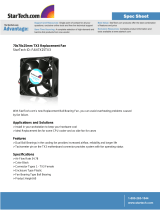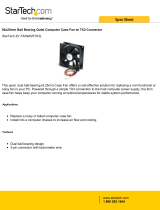Page is loading ...

Advance Technologies; Automate the World.
Manual Rev. 2.04
Revision Date: November 15, 2010
Part No: 50-15054-1020
PCIS-8580-4S
PCIS-8580-13S
User’s Manual

Copyright 2009, 2010 ADLINK TECHNOLOGY INC.
All Rights Reserved.
The information in this document is subject to change without prior
notice in order to improve reliability, design, and function and does
not represent a commitment on the part of the manufacturer.
In no event will the manufacturer be liable for direct, indirect, spe-
cial, incidental, or consequential damages arising out of the use or
inability to use the product or documentation, even if advised of
the possibility of such damages.
This document contains proprietary information protected by copy-
right. All rights are reserved. No part of this manual may be repro-
duced by any mechanical, electronic, or other means in any form
without prior written permission of the manufacturer.
Trademarks
Product names mentioned herein are used for identification pur-
poses only and may be trademarks and/or registered trademarks
of their respective companies.

Getting Service from ADLINK
Contact us should you require any service or assistance.
ADLINK Technology, Inc.
Address: 9F, No.166 Jian Yi Road, Chungho City,
Taipei County 235, Taiwan
קᗼխࡉؑ৬ԫሁ 166 ᇆ 9 ᑔ
Tel: +886-2-8226-5877
Fax: +886-2-8226-5717
Email: [email protected]
Ampro ADLINK Technology, Inc.
Address: 5215 Hellyer Avenue, #110, San Jose, CA 95138, USA
Tel: +1-408-360-0200
Toll Free: +1-800-966-5200 (USA only)
Fax: +1-408-360-0222
Email: [email protected]
ADLINK Technology (China) Co., Ltd.
Address: Ϟ⍋Ꮦ⌺ϰᮄऎᓴ∳催⾥ᡔುऎ㢇䏃 300 ো(201203)
300 Fang Chun Rd., Zhangjiang Hi-Tech Park,
Pudong New Area, Shanghai, 201203 China
Tel: +86-21-5132-8988
Fax: +86-21-5132-3588
Email: [email protected]
ADLINK Technology Beijing
Address: ࣫ҀᏖ⍋⎔ऎϞഄϰ䏃 1 োⲜ߯ࡼॺ E ᑻ 801 ᅸ(100085)
Rm. 801, Power Creative E, No. 1, B/D
Shang Di East Rd., Beijing, 100085 China
Tel: +86-10-5885-8666
Fax: +86-10-5885-8625
Email: [email protected]
ADLINK Technology Shenzhen
Address: ⏅ഇᏖफቅऎ⾥ᡔುफऎ催ᮄफϗ䘧᭄ᄫᡔᴃು
A1 ᷟ 2 ὐ C ऎ (518057)
2F, C Block, Bldg. A1, Cyber-Tech Zone, Gao Xin Ave. Sec. 7,
High-Tech Industrial Park S., Shenzhen, 518054 China
Tel: +86-755-2643-4858
Fax: +86-755-2664-6353
Email: [email protected]

ADLINK Technology (Europe) GmbH
Address: Nord Carree 3, 40477 Duesseldorf, Germany
Tel: +49-211-495-5552
Fax: +49-211-495-5557
Email: [email protected]
ADLINK Technology, Inc. (French Liaison Office)
Address: 15 rue Emile Baudot, 91300 Massy CEDEX, France
Tel: +33 (0) 1 60 12 35 66
Fax: +33 (0) 1 60 12 35 66
Email: [email protected]
ADLINK Technology Japan Corporation
Address: 151-0072 ᧲੩ㇺᷦ⼱ᐈ䊱⼱㩷
1-1-2 ᦺᣣ↢ᐈ䊱⼱䊎䊦 8F
Asahiseimei Hatagaya Bldg. 8F
1-1-2 Hatagaya, Shibuya-ku, Tokyo 151-0072, Japan
Tel: +81-3-4455-3722
Fax: +81-3-5333-6040
Email: [email protected]
ADLINK Technology, Inc. (Korean Liaison Office)
Address: 昢殾柢 昢爎割 昢爎壟 1506-25 穢壊 B/D 2 猻
2F, Hando B/D, 1506-25, Seocho-Dong, Seocho-Gu,
Seoul 137-070, Korea
Tel: +82-2-2057-0565
Fax: +82-2-2057-0563
Email: [email protected]
ADLINK Technology Singapore Pte. Ltd.
Address: 84 Genting Lane #07-02A, Cityneon Design Centre,
Singapore 349584
Tel: +65-6844-2261
Fax: +65-6844-2263
Email: singapore@adlinktech.com
ADLINK Technology Singapore Pte. Ltd. (Indian Liaison Office)
Address: No. 1357, "Anupama", Sri Aurobindo Marg, 9th Cross,
JP Nagar Phase I, Bangalore - 560078, India
Tel: +91-80-65605817
Fax: +91-80-22443548
Email: india@adlinktech.com

Table of Contents i
Table of Contents
Table of Contents..................................................................... i
List of Tables.......................................................................... iii
List of Figures........................................................................ iv
1 Introduction ........................................................................ 1
1.1 Features............................................................................... 2
PCIS-8580-4S .................................................................2
PCIS-8580-13S ...............................................................2
1.2 Applications ......................................................................... 2
1.3 Specifications....................................................................... 3
LPCI-8575 PCI-PCI Expansion Card ..............................3
RK-8005 Expansion chassis ...........................................4
RK-8014 Expansion chassis ...........................................5
ACL-PCIEXT-2 Cable .....................................................5
General ...........................................................................5
2 Installation .......................................................................... 7
2.1 Content of package.............................................................. 7
2.2 Unpacking............................................................................ 8
2.3 Getting Start......................................................................... 8
Install PCI Expansion Card into your Host System .........8
Driver Installation ............................................................9
Install your PCI Card into the Expansion Chassis ........10
Connect to Expansion Chassis .....................................12
Power-on Sequence .....................................................12
3 Hardware Overview.......................................................... 13
3.1 System Architecture........................................................... 13
Operation Theory .........................................................13
3.2 LPCI-8575 PCI Expansion Card........................................ 14
Functional Block ...........................................................14
Jumper Settings for LPCI-8575 ....................................15
3.3 BP-8005............................................................................. 19
Backplane Architecture .................................................19
Jumpers and Connectors ..............................................22
Jumpers and connectors on the bottom side ................22

ii Table of Contents
3.4 RK-8005............................................................................. 23
Mechanical Drawing of RK-8005 ..................................23
3.5 BP-8014............................................................................. 24
Backplane Architecture .................................................24
Jumpers and Connectors ..............................................25
3.6 RK-8014............................................................................. 26
Mechanical Drawing of RK-8014 ..................................26
3.7 ACL-PCIEXT-2................................................................... 27
Pin Assignment of ACL-PCIEXT-2 ...............................27

List of Tables iii
List of Tables
Table 1-1: Power requirements ................................................. 3
Table 3-1: Jumpers and connectors on the LPCI-8575 ........... 15
Table 3-2: JP1 Settings ........................................................... 16
Table 3-3: JP2 Settings ........................................................... 16
Table 3-4: JP3 Settings ........................................................... 17
Table 3-5: D2 Display .............................................................. 18
Table 3-6: Top side jumpers and connectors .......................... 22
Table 3-7: Bottom side jumpers and connectors ..................... 22
Table 3-8: BP-8014 jumpers and connectors .......................... 25
Table 3-9: Pin Assignment of ACL-PCIEXT-2 ......................... 27

iv List of Figures
List of Figures
Figure 2-1: Install the PCI expansion card into your host system 9
Figure 2-2: Installing the driver for PCI expansion card............. 10
Figure 2-3: Install your PCI cards into the expansion chassis (using
the PCIS-8580-4S as an example).......................... 11
Figure 2-4: Connect you host computer and expansion chassis (us-
ing the PCIS-8580-4S as an example).................... 12
Figure 3-1: Operation theory of PCIS-8580 PCI-to-PCI expansion
system ..................................................................... 13
Figure 3-2: Concept of the serialized PCI bridge....................... 14
Figure 3-3: Jumpers and connectors on the LPCI-8575............ 15
Figure 3-4: Top view of BP-8005 backplane.............................. 20
Figure 3-5: Bottom view of BP-8005 backplane......................... 21
Figure 3-6: Mechanical drawing of RK-8005.............................. 23
Figure 3-7: Top view of BP-8014 backplane.............................. 24
Figure 3-8: Mechanical drawing of RK-8014.............................. 26
Figure 3-9: DVI Connector pins and dimensions ....................... 27

Introduction 1
1 Introduction
The ADLINK PCIS-8580 is the PCI-to-PCI expansion systems for
extending your PCI buses of the host computers. With the state-
of-art StarFabric high-speed serial link technology, you can extend
your PCI bus of the host computer to an external chassis, which
accommodates 4 (PCIS-8580-4S) or 13 (PCIS-8580-13S) addi-
tional PCI slots. This advanced technology provides full 32-bit/
33MHz PCI bandwidth (132MB/s) and maximal 10m distance
between host computer and expansion chassis. In addition,
ADLINK PCI-to-PCI expansion system utilizes the concept of
“serialized bridge” to provide complete hardware and software
transparency to your host system. Any hardware installed in the
expansion chassis works as it’s inside the host system without any
driver/software effort.
The ADLINK PCIS-8580 PCI-to-PCI expansion system is com-
posed of three major components: a PCI expansion card (LPCI-
8575), an expansion chassis (RK-8005 for PCIS-8580-4S or RK-
8014 for PCIS-8580-13S), and a cable (ACL-PCIEXT-2). The PCI
expansion card is the core of this system. It acts as a PCI bridge
with the capability to serialize the PCI signals and maintain a
5Gbps serial link between the host system and the expansion
chassis. The expansion chassis, which is a 4-slot wall-mount
chassis (RK-8005) or a 13-slot rack-mount chassis (RK-8014), is
the platform to accommodate PCI slots. It contains a backplane, a
power supply, and a pre-installed PCI expansion card. The cable,
which consists of DVI-D connector and shielding twisted pairs,
provides robust connectivity and satisfying signal quality between
the host computer and the expansion chassis.

2Introduction
1.1 Features
PCIS-8580-4S
PCI local bus specification Rev 2.2 compliant
PCI bridge architecture specification Rev 1.2 compliant
Provides 4 extended half-size PCI slots
Full 32-bit/33MHz PCI bandwidth expansion (132MB/s)
Maximal 10m expansion distance
Complete hardware and software transparency
24-pin DVI-D connector for robust connectivity
Shoebox size wall-mount chassis with built-in 200W power
supply
PCIS-8580-13S
PCI local bus specification Rev 2.2 compliant
PCI bridge architecture specification Rev 1.2 compliant
Provides 13 extended full-size PCI slots
Full 32-bit/33MHz PCI bandwidth expansion (132MB/s)
Maximum 10m expansion distance
Complete hardware and software transparency
24-pin DVI-D connector for robust connectivity
19” rack-mound chassis with built-in 400W power supply
1.2 Applications
Industrial automation/control
Electronics manufacturing test
Military/aerospace
Video capture
Remote test and measurement

Introduction 3
1.3 Specifications
LPCI-8575 PCI-PCI Expansion Card
PCI local bus specification Rev 2.2 compliant
PCI bridge architecture specification Rev 1.2 compliant
Supports both 5V and 3.3V PCI bus
Data throughput: full 32-bit/33MHz PCI bandwidth (132MB/
s)
I/O connector: DVI-D 24-pin connector
Link indicator (Green LED)
Off: Expansion or host computer does not power on
On: Link status is good
Blink: Link status is failed. Check your cable or power-on
sequence.
Maximum extended distance: 10m
Power requirements
+5V +3.3V
190mA 250mA
Table 1-1: Power requirements

4Introduction
RK-8005 Expansion chassis
Dimensions: 122mm(W) x 195mm(H) x 260mm(D)
Weight: 3.2 Kg (7.04lb)
Backplane: 5x 32-bit/33MHz half-size PCI slots
1 slot for expansion card
4 slots available for PCI cards
Front-panel indicators
Power indicator (Red LED)
Link indicator (Green LED)
Off: Expansion or host computer does not power on
On: Link status is good
Blink: Link status is failed. Check your cable or power-
on sequence.
Power supply
Input voltage: 85VAC to 265VAC, auto-switching
Output: 200W
Cooling: One 37.5 CFM ball bearing fan (80mm)

Introduction 5
RK-8014 Expansion chassis
Dimensions: 438.5mm(W) x 177mm(H) x 448.5mm(D)
Weight: 12 kg (26.4lb)
Backplane: 14x 32-bit/33MHz full-size PCI slots
1 slot for expansion card
13 slots available for PCI cards
Front-panel indicators
Power indicator (Red LED)
Link indicator (Green LED)
Off: Expansion or host computer does not power on
On: Link status is good
Blink: Link status is failed. Check your cable or power-
on sequence.
Power supply
Input voltage: 85VAC to 265VAC, auto-switching
Output: 400W
Cooling: Two 88 CFM ball bearing fan (120mm)
ACL-PCIEXT-2 Cable
Length: 2m
Construction: 8 pairs of shielding twisted copper wires
Connector: DVI-D 24-pin
Other cable options
ACL-PCIEXT-5: 5m
ACL-PCIEXT-10: 10m
General
Operating temperature: 0C to 50C
Storage temperature : -20C to 80C
Relative humidity: 10 to 90%, non-condensing

6Introduction

Installation 7
2 Installation
This chapter outlines the contents of package, describes unpack-
ing information, and describes how to set up the PCIS-8580 PCI-
to-PCI expansion system and install your PCI cards.
2.1 Content of package
PCIS-8580-4S package includes the following items:
One LPCI-8575 in a individual carton
One wall-mount chassis, which contains the following com-
ponents pre-installed:
One LPCI-8575
One 5-slot backplane
One 200W AC power supply
One ACL-PCIEXT-2 cable
One AC power cord
Wall-mount kit for chassis
This User’s Manual
PCIS-8580-13S package includes the following items:
One LPCI-8575 in a individual carton
One rack-mount chassis, which contains the following com-
ponents pre-installed:
One LPCI-8575
One 14-slot backplane
One 400W AC power supply
One ACL-PCIEXT-2 cable
One AC power cord
This User’s Manual
If any of these items are missing or damaged, contact your
ADLINK dealer. Save the shipping materials and carton in to ship
or store the product in the future.

8Installation
2.2 Unpacking
The ADLINK PCIS-8580 system contains some electro-static sen-
sitive components that can be easily be damaged by static elec-
tricity. For this reason, the card and chassis should be handled on
a grounded anti-static mat and the operator should wear an anti-
static wristband during the unpacking and installation procedure.
Please also inspect the components for apparent damage.
Improper shipping and handling may cause damage to the compo-
nents. Be sure there are no shipping and handling damage on the
components before continuing.
You are now ready to set up your PCIS-8580 PCI-to-PCI expan-
sion system.
Note: DO NOT APPLY POWER TO THE CARD OR CHASSIS IF
IT HAS BEEN DAMAGED.
2.3 Getting Start
In this section, we’ll illustrate the step-by-step instructions to set
up your PCIS-8580 PCI-to-PCI expansion system.
Install PCI Expansion Card into your Host System
The first step is to install the PCI expansion card (LPCI-8575) into
your host system. You can find an individual carton in the whole
package which contains the PCI expansion card. The steps of
installation are:
1. Turn off your host computer.
2. Open the chassis of the host computer.
3. Remove the package of PCI expansion card. (Please
wear your anti-static facilities when you handle the card.)
4. Plug the PCI expansion card into an available PCI slot
and screw it to the chassis.
5. Close the chassis.

Installation 9
Figure 2-1: Install the PCI expansion card into your host system
Driver Installation
After installing the PCI expansion card into your host computer,
now you can turn on your computer and install the driver of PCI
expansion card. Please follow the following steps to finish the
driver installation.
1. Insert the ADLINK ALL-In-One CD.
2. Execute x:\Driver Installation\PCI Expan-
sion\PCIS_8580_setup.exe to launch the setup pro-
gram. (x: denotes your CD-ROM drive). A InstallShield®
wizard appears to guide you finish the setup procedure.

10 Installation
Figure 2-2: Installing the driver for PCI expansion card
3. While setup finishes, please reboot your system. (Note:
According to different hardware configuration, you may
need to reboot your computer for several times to detect
the StarFabric serialized bridge and its subsequent PCI
devices.)
Install your PCI Card into the Expansion Chassis
The PCIS-8580 expansion chassis can accommodate 4 additional
PCI slots (PCIS-8580-4S) or 13 additional PCI slots (PCIS-8580-
13S). This section illustrates the procedures to install your PCI
cards into the expansion chassis.
1. Open the expansion chassis by loosen the screws and
remove the top cover of the chassis. You’ll see a back-
plane inside the chassis.

Installation 11
2. Plug you PCI cards into the expansion chassis and
screw them to the chassis.
3. Put the top cover and tighten the screws.
Figure 2-3: Install your PCI cards into the expansion chassis (using the
PCIS-8580-4S as an example)

12 Installation
Connect to Expansion Chassis
Your host computer and the expansion chassis are connected via
a cable (ACL-PCIEXT-2). This cable uses the DVI-D connector
and customized shielding twisted pairs to make a robust high-
speed serial link. Please DO NOT use standard DVI cable to con-
nect your host computer and the expansion chassis.
Figure 2-4: Connect you host computer and expansion chassis (using the
PCIS-8580-4S as an example)
Power-on Sequence
To make the PCI-to-PCI expansion system works well, you need
to follow a correct power-on sequence for both expansion chassis
and host computer. The LINK indicators (a green LED) on the
front-panel of the expansion chassis and LPCI-8575 indicate the
status of serial link between the expansion chassis and the host
computer. When the LINK LED is on, the link is good, otherwise
when the LINK LED is off or blinking, the link is failed.
1. Make sure the cable is correctly connected and screw
the connectos.
2. Turn on the expansion chassis.
3. Turn on the host computer. At this time you’ll see the
LINK indicators on both sides are on.
/



